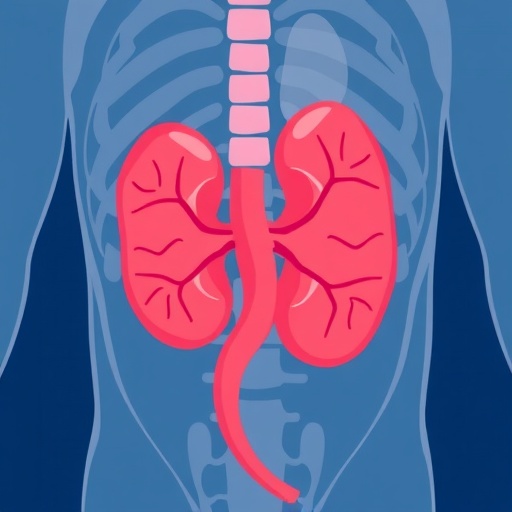In the realm of pediatric medicine, one of the pressing concerns in managing kidney-related disorders involves the accurate interpretation of renal scarring. This condition can significantly affect the long-term health outcomes of children, making precise diagnostic techniques crucial. A recently published study spearheaded by researchers Naznine, Chowdhury, and Salam has turned the spotlight on technetium-99m dimercaptosuccinic acid (DMSA) scintigraphy, a nuclear medicine imaging technique used to evaluate renal structure and function. The study, which will undoubtedly contribute to clinical practice, aims to assess the consistency of interpretations regarding renal scarring in pediatric patients using this method.
DMSA scintigraphy is widely acknowledged for its role in identifying renal cortical defects, notably scarring, which is a significant sequela of urinary tract infections (UTIs) in children. The technique utilizes a radiopharmaceutical that binds to renal cortical tissue, allowing for clear imaging of kidney function and morphology. While this method has been instrumental in guiding treatment plans, the variability in interpretation among different healthcare providers raises questions regarding its reliability and the implications for pediatric care.
The core of the recently conducted study revolves around evaluating inter-observer variability among pediatric radiologists when assessing DMSA scintigraphy results. The researchers gathered a diverse cohort of pediatric cases and presented radiologists with anonymized scans. Their task was to diagnose and characterize renal scarring based on the images provided. The results indicated a varied level of agreement among the radiologists, a finding that emphasizes the need for improved standards in interpretation and training within this specialized field.
Inter-observer variability is not a new issue in medical imaging; however, its ramifications become more profound in pediatric care, where misinterpretations can lead to misdiagnosis and inappropriate treatment plans. The study’s findings underscore the importance of consistency in the interpretation of imaging studies to avoid detrimental outcomes, such as unnecessary surgical interventions or delayed treatment strategies. Addressing these discrepancies is crucial for nurturing a foundation of trust in diagnostic imaging among healthcare providers and caregivers alike.
Moreover, the evidence gathered by Naznine and colleagues has significant implications for clinical practice. The intention is to inspire collaborative efforts among radiologists, nephrologists, and pediatricians to establish a standardized approach to interpreting DMSA scans. Such standardization would not only enhance diagnostic accuracy but also improve the overall management of renal conditions in children.
In recent years, there has been a growing discourse surrounding the role of artificial intelligence (AI) in healthcare, particularly in imaging diagnostics. While the study does not delve deeply into AI applications, it hints at a future where machine learning algorithms could aid in minimizing variability among human interpretations. Automated systems can process vast amounts of data and potentially discern patterns that might elude even seasoned radiologists.
As pediatric health continues to evolve, the incorporation of advanced technology will gain traction. The potential for AI to analyze DMSA scintigraphy images could revolutionize the field, providing not only consistency but also real-time decision support to clinicians. This raises tantalizing prospects for enhancing patient outcomes and alleviating strain on healthcare systems through timely and accurate diagnoses.
Another exciting dimension brought forth by the study is the focus on the long-term consequences of renal scarring in children. Since early identification and intervention are pivotal, understanding the variabilities in imaging interpretation could reshape screening protocols for high-risk pediatric populations. Addressing renal scarring proactively may help mitigate risks associated with hypertension and chronic kidney disease later in life.
The researchers employed robust statistical methodologies to assess agreement rates, utilizing kappa statistics as a measure of concordance among observers. Their findings revealed both high and low levels of agreement on various cases, illustrating that while some scenarios are easily interpreted, others remain contentious. These nuances highlight the complexity inherent in medical imaging and the need for continuous education among healthcare professionals.
It is also worth noting how challenges in achieving a uniform diagnostic standard can be compounded by differing training backgrounds and institutional practices among healthcare providers. The implications tied to these findings extend beyond immediate patient care to encompass broader healthcare policies focused on ensuring quality standards across pediatric radiology services.
Looking ahead, the study advocates for the establishment of comprehensive guidelines that can serve as a reference for interpreting DMSA scintigraphy in pediatric patients. Such initiatives would not only aid individual practitioners but also foster a collaborative climate among multidisciplinary teams, ensuring that all stakeholders are aligned in their understanding and approach.
In conclusion, Naznine, Chowdhury, and Salam’s research serves as a clarion call to the medical community to acknowledge and address the issues surrounding inter-observer variability in pediatric imaging, specifically with DMSA scintigraphy. As our understanding of these challenges deepens, it becomes increasingly clear that cohesive collaborative strategies and the integration of technological advancements are paramount. The future of pediatric renal health may well depend on our ability to develop and maintain a high level of consistency in diagnostic imaging practices.
This dialogue serves as an essential reminder of the critical role that technological integration, collaborative approaches, and continued education play in enhancing the quality of care delivered to vulnerable patient populations, such as children with renal scarring. The path ahead must involve commitment from all sectors of the healthcare community to actively work towards improved standards and practices, ultimately leading to enhanced outcomes for child patients across the globe.
Subject of Research: Consistency of Interpretation of Renal Scarring in Pediatric Patients Using Technetium-99m DMSA Scintigraphy
Article Title: How consistent is the interpretation of renal scarring in pediatric patients using technetium-99m dimercaptosuccinic acid scintigraphy.
Article References:
Naznine, M., Chowdhury, M., Salam, A. et al. How consistent is the interpretation of renal scarring in pediatric patients using technetium-99m dimercaptosuccinic acid scintigraphy.
Pediatr Radiol (2025). https://doi.org/10.1007/s00247-025-06379-z
Image Credits: AI Generated
DOI: https://doi.org/10.1007/s00247-025-06379-z
Keywords: renal scarring, pediatric radiology, technetium-99m DMSA scintigraphy, inter-observer variability, diagnostic accuracy, artificial intelligence in healthcare.




